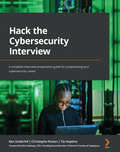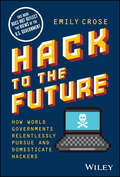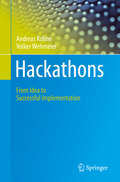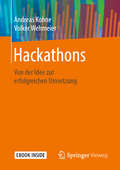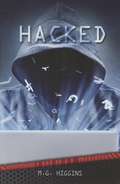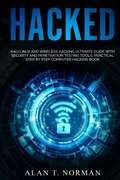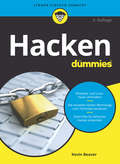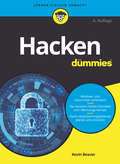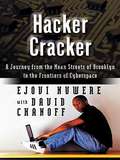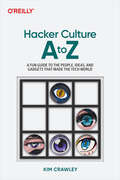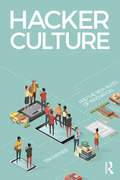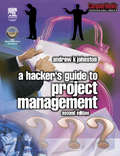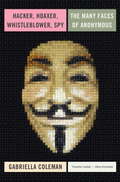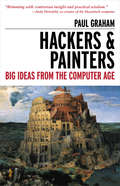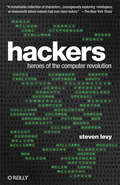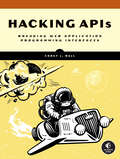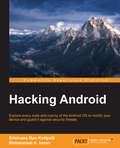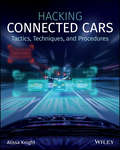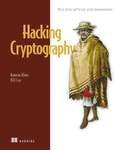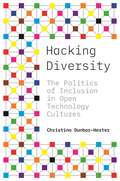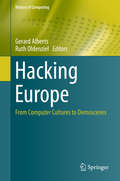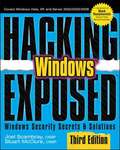- Table View
- List View
Hack the Cybersecurity Interview: A complete interview preparation guide for jumpstarting your cybersecurity career
by Ken Underhill Christophe Foulon Tia Hopkins Mari GallowayGet your dream job and set off on the right path to achieving success in the cybersecurity field with expert tips on preparing for interviews, understanding cybersecurity roles, and moreKey FeaturesGet well-versed with the interview process for cybersecurity job rolesPrepare for SOC analyst, penetration tester, malware analyst, digital forensics analyst, CISO, and more rolesUnderstand different key areas in each role and prepare for themBook DescriptionThis book is a comprehensive guide that helps both entry-level and experienced cybersecurity professionals prepare for interviews in a wide variety of career areas.Complete with the authors' answers to different cybersecurity interview questions, this easy-to-follow and actionable book will help you get ready and be confident. You'll learn how to prepare and form a winning strategy for job interviews. In addition to this, you'll also understand the most common technical and behavioral interview questions, learning from real cybersecurity professionals and executives with years of industry experience.By the end of this book, you'll be able to apply the knowledge you've gained to confidently pass your next job interview and achieve success on your cybersecurity career path.What you will learnUnderstand the most common and important cybersecurity rolesFocus on interview preparation for key cybersecurity areasIdentify how to answer important behavioral questionsBecome well versed in the technical side of the interviewGrasp key cybersecurity role-based questions and their answersDevelop confidence and handle stress like a proWho this book is forThis cybersecurity book is for college students, aspiring cybersecurity professionals, computer and software engineers, and anyone looking to prepare for a job interview for any cybersecurity role. The book is also for experienced cybersecurity professionals who want to improve their technical and behavioral interview skills. Recruitment managers can also use this book to conduct interviews and tests.
Hack the Cybersecurity Interview: Navigate Cybersecurity Interviews with Confidence, from Entry-level to Expert roles
by Christophe Foulon Ken Underhill Tia HopkinsAce your cybersecurity interview by unlocking expert strategies, technical insights, and career-boosting tips for securing top roles in the industryKey FeaturesMaster technical and behavioral interview questions for in-demand cybersecurity positions Improve personal branding, communication, and negotiation for interview success Gain insights into role-specific salary expectations, career growth, and job market trendsBook DescriptionThe cybersecurity field is evolving fast, and so are its job interviews. Hack the Cybersecurity Interview, Second Edition is your go-to guide for landing your dream cybersecurity job—whether you're breaking in or aiming for a senior role. This expanded edition builds on reader feedback, refines career paths, and updates strategies for success. With a real-world approach, it preps you for key technical and behavioral questions, covering roles like Cybersecurity Engineer, SOC Analyst, and CISO. You'll learn best practices for answering with confidence and standing out in a competitive market. The book helps you showcase problem-solving skills, highlight transferable experience, and navigate personal branding, job offers, and interview stress. Using the HACK method, it provides a structured approach to adapt to different roles and employer expectations. Whether you're switching careers, advancing in cybersecurity, or preparing for your first role, this book equips you with the insights, strategies, and confidence to secure your ideal cybersecurity job.What you will learnIdentify common interview questions for different roles Answer questions from a problem-solving perspectiveBuild a structured response for role-specific scenario questionsTap into your situational awareness when answering questionsShowcase your ability to handle evolving cyber threatsGrasp how to highlight relevant experience and transferable skillsLearn basic negotiation skillsLearn strategies to stay calm and perform your best under pressure Who this book is forThis book is ideal for anyone who is pursuing or advancing in a cybersecurity career. Whether professionals are aiming for entry-level roles or executive ones, this book will help them prepare for interviews across various cybersecurity paths. With common interview questions, personal branding tips, and technical and behavioral skill strategies, this guide equips professionals to confidently navigate the interview process and secure their ideal cybersecurity job.
Hack to The Future: How World Governments Relentlessly Pursue and Domesticate Hackers
by Emily CroseUnderstand the history of hacking culture and the genesis of a powerful modern subculture In Hack to the Future: How World Governments Relentlessly Pursue and Domesticate Hackers, veteran information security professional Emily Crose delivers a deep dive into the history of the United States government's nuanced relationship with hacker culture and the role the latter has played in the former's domestic policy and geopolitics. In the book, you'll learn about significant events that have changed the way the hacking community has been perceived by the public, the state, and other hackers. The author explains how the US government managed to weaponize a subculture widely seen as misanthropic and awkward into a lever of geopolitical power. You'll also discover how: The release of the Morris worm and the Melissa virus changed the way hackers were seen and treated in the United States Different government agencies, including the National Security Agency and NASA treated – and were treated by – domestic hackers Hacking went from being an exclusive hobby for socially awkward nerds to a substantial lever of geopolitical power in just a few decades Perfect for anyone with an interest in hacking, tech, infosec, and geopolitics, Hack to the Future is a must-read for those who seek to better their understanding of the history of hacking culture and how we got to where we are today.
Hackathons: From Idea to Successful Implementation
by Andreas Kohne Volker WehmeierThis book provides a detailed and comprehensive overview of all phases of a hackathon and thus helps to reduce complexity, to use opportunities, to avert pitfalls and to avoid problems. In addition, it also explains from a participant’s perspective how to succeed in a hackathon. Lastly, the book is rounded off by extensive checklists, which support you in your own hackathons. The book is structured as follows: At first the basics and the history of hackathons are described in chapter 1. Afterwards the three phases of a hackathon are described in detail. This is started in chapter 2 with the description of the individual measures which are to be accomplished before the actual event. Here not only technical or organizational aspects are described, but also the important legal aspects are discussed. Subsequently, it is shown what is necessary to carry out a hackathon successfully. For this purpose the actual execution with all its steps is described in chapter 3. Next, chapter 4 looks at the follow-ups, which are often neglected or even completely forgotten. Chapter 5 describes from a participant’s point of view the reasons for participating in a hackathon and which aspects guarantee a successful participation. In the following chapter 6 the criticism of the format of the hackathons and their execution is also examined in detail. Eventually, the most important points are summarized in chapter 7, before chapter 8 gives a view into the future of hackathons. Subsequently chapter 9 collects statements and opinions of representatives from industry, science and administration on the topic of hackathons. The book is rounded off in chapter 10 with detailed checklists, which can be directly used for the successful planning, operation and follow-up of hackathons. The book is written for everyone with an interest in how hackathons work, how to create them, and how to successfully participate. It especially targets people in industry or young students who want to run or participate in a hackathon.
Hackathons: Von der Idee zur erfolgreichen Umsetzung
by Andreas Kohne Volker WehmeierErfahren Sie in diesem Buch mehr über das Phänomen HackathonsEs gibt Events, die ermöglichen es ihren Akteuren, interdisziplinär in einen kreativen Dialog zu treten. Dieses Buch widmet sich den sogenannten Hackathons – einem Veranstaltungsformat, das sich seit Jahren großer Beliebtheit erfreut. Die Erfolgsgeschichte begann wie so oft in Amerika, mittlerweile wird das disruptive Brainstorming jedoch weltweit erfolgreich durchgeführt, umin kürzester Zeit Technologien, Geschäftsmodelle und Produkte zu entwickeln.neues Personal zu rekrutieren.interdisziplinäre Teams effizient zusammenzubringen.Das Ergebnis kann u. a. eine kollaborative Software- und Hardwareentwicklung sein. Dieses Buch von Andreas Kohne und Volker Wehmeier widmet sich nicht nur der Frage, was ein Hackathon ist, sondern erklärt Ihnen zudem, wie Sie einen Hackathon organisieren und worauf Sie bei der Durchführung eines solchen Events achten sollten.Programmieren, Recruiting und InnovationenDie Entwicklung neuer Ideen, Konzepte und Lösungen sowie das Testen verschiedener Projekte stehen stets im Fokus der Teilnehmer unterschiedlicher Branchen. Gleichzeitig bieten sie Start-ups die perfekte Gelegenheit, um ihr Geschäftsmodell von Experten bewerten zu lassen. Sie können sich vorstellen, wie wichtig daher die Planung eines solchen Events für alle Beteiligten ist. In diesem Buch über Hackathons erhalten Sie einen ebenso praxisnahen wie kompakten Überblick über folgende Bereiche:PlanungDurchführungNachbereitungMehrwertUm Ihnen den Einstieg in die Thematik zu erleichtern, finden Sie am Ende des Werkes neben prägnanten Checklisten auch Ablaufübersichten. Das Buch fokussiert sich nicht nur auf die Veranstalter eines Hackathons. Es berücksichtigt ebenfalls die Teilnehmersicht sowie die Stimmen aus der Wirtschaft und Verwaltung. Dadurch erhalten Sie umfassenden Input von beiden Seiten.
Hacked (Red Rhino Nonfiction)
by M. G. Higgins<p>Look out! Your computer data is not safe. There are hackers who will steal it. Sell it. Or destroy it. The hackers are getting smarter. They leave little trace as to their identities. And there are dangerous consequences for individuals, corporations, and governments. <p>Engage your most struggling readers in grades 3-8 with Red Rhino Nonfiction! This new series features high-interest topics in every content area. Visually appealing full-color photographs and illustrations, fun facts, and short chapters keep emerging readers focused. Written at a 1.5-1.9 readability level, these books include pre-reading comprehension questions and a 20-word glossary for comprehension support.</p>
Hacked: Kali Linux And Wireless Hacking Ultimate Guide With Security And Penetration Testing Tools, Practical Step By Step Computer Hacking Book
by Alan NormanHacking book is intended to serve as an intermediate-level guide to some common penetration testing tools and skills – particularly those of wireless hacking and of maintaining anonymity. The book concentrates more on practical execution, and provides some step-by-step procedures for installing essential platforms and tools, as well as the theory behind some basic attacks. Gain the ability to do ethical hacking and penetration testing by taking this hacking book! Get answers from an experienced IT expert to every single question you have related to the learning you do in this book including: - installing Kali Linux - using VirtualBox - basics of Linux - Staying anonymous with Tor - Proxychains, Virtual Private Networks (VPN) - Macchanger, Nmap - cracking wifi - aircrack - cracking Linux passwords What are the requirements? - Reliable and fast internet connection. - Wireless networking card. - Kali Linux Distribution - Basic IT skills What will you get from the hacking book? Answers to every single question you have about ethical hacking and penetration testing from an experienced IT professional! - You will learn the basics of network - Deal with a lot of Kali Linux tools - Learn some Linux commands Tips for remaining anonymous in hacking and penetration testing activities. Protect your WiFi network against all the attacks Gain access to any client account in the WiFi network A complete tutorial explaining how to build a virtual hacking environment, attack networks, and break passwords. Step by step instructions for insulation VirtualBox and creating your virtual environment on Windows, Mac, and Linux.
Hacken für Dummies (Für Dummies)
by Kevin BeaverUm einen Hacker zu überlisten, müssen Sie sich in die Denkweise des Hackers hineinversetzen. Deshalb lernen Sie mit diesem Buch, wie ein Bösewicht zu denken. Der Fachmann für IT-Sicherheit Kevin Beaver teilt mit Ihnen sein Wissen über Penetrationstests und typische Schwachstellen in IT-Systemen. Er zeigt Ihnen, wo Ihre Systeme verwundbar sein könnten, sodass Sie im Rennen um die IT-Sicherheit die Nase vorn behalten. Denn wenn Sie die Schwachstellen in Ihren Systemen kennen, können Sie sie besser schützen und die Hacker kommen bei Ihnen nicht zum Zug!
Hacken für Dummies (Für Dummies)
by Kevin BeaverUm einen Hacker zu überlisten, müssen Sie sich in dessen Denkweise hineinversetzen. Deshalb lernen Sie mit diesem Buch, wie ein Bösewicht zu denken. Der Fachmann für IT-Sicherheit Kevin Beaver teilt mit Ihnen sein Wissen über Penetrationstests und typische Schwachstellen in IT-Systemen. Er zeigt Ihnen, wo Ihre Systeme verwundbar sein könnten, sodass Sie im Rennen um die IT-Sicherheit die Nase vorn behalten. Denn nur wenn Sie die Schwachstellen in Ihren Systemen kennen, können Sie sich richtig dagegen schützen und die Hacker kommen bei Ihnen nicht zum Zug!
Hacker Cracker: A Journey from the Mean Streets of Brooklyn to the Frontiers of Cyberspace
by David Chanoff Ejovi NuwereLike other kids in the Bedford-Stuyvesant neighborhood of Brooklyn, Ejovi Nuwere grew up among thugs and drug dealers. When he was eleven, he helped form a gang; at twelve, he attempted suicide. In his large, extended family, one uncle was a career criminal, one a graduate student with his own computer. By the time Ejovi was fourteen, he was spending as much time on the computer as his uncle was. Within a year he was well on his way to a hacking career that would lead him to one of the most audacious and potentially dangerous computer break-ins of all time, secret until now. Before he finished high school he had created a hidden life in the hacker underground and an increasingly prominent career as a computer security consultant. At the age of twenty-two, he was a top security specialist for one of the world's largest financial houses. Hacker Cracker is at once the most candid revelation to date of the dark secrets of cyberspace and the simple, unaffected story of an inner-city child's triumph over shattering odds to achieve unparalleled success.
Hacker Culture A to Z: A Fun Guide to the People, Ideas, and Gadgets That Made the Tech World
by Kim CrawleyHacker culture can be esoteric, but this entertaining reference is here to help. Written by longtime cybersecurity researcher and writer Kim Crawley, this fun reference introduces you to key people and companies, fundamental ideas, and milestone films, games, and magazines in the annals of hacking. From airgapping to phreaking to zombie malware, grasping the terminology is crucial to understanding hacker culture and history.If you're just getting started on your hacker journey, you'll find plenty here to guide your learning and help you understand the references and cultural allusions you come across. More experienced hackers will find historical depth, wry humor, and surprising facts about familiar cultural touchstones.Understand the relationship between hacker culture and cybersecurityGet to know the ideas behind the hacker ethos, like "knowledge should be free" Explore topics and publications central to hacker culture, including 2600 MagazineAppreciate the history of cybersecurityLearn about key figures in the history of hacker cultureUnderstand the difference between hackers and cybercriminals
Hacker Culture and the New Rules of Innovation
by Tim RaynerFifteen years ago, a company was considered innovative if the CEO and board mandated a steady flow of new product ideas through the company’s innovation pipeline. Innovation was a carefully planned process, driven from above and tied to key strategic goals. Nowadays, innovation means entrepreneurship, self-organizing teams, fast ideas and cheap, customer experiments. Innovation is driven by hacking, and the world’s most innovative companies proudly display their hacker credentials. Hacker culture grew up on the margins of the computer industry. It entered the business world in the twenty-first century through agile software development, design thinking and lean startup method, the pillars of the contemporary startup industry. Startup incubators today are filled with hacker entrepreneurs, running fast, cheap experiments to push against the limits of the unknown. As corporations, not-for-profits and government departments pick up on these practices, seeking to replicate the creative energy of the startup industry, hacker culture is changing how we think about leadership, work and innovation. This book is for business leaders, entrepreneurs and academics interested in how digital culture is reformatting our economies and societies. Shifting between a big picture view on how hacker culture is changing the digital economy and a detailed discussion of how to create and lead in-house teams of hacker entrepreneurs, it offers an essential introduction to the new rules of innovation and a practical guide to building the organizations of the future.
Hacker States (The Information Society Series)
by Adam Fish Luca FollisHow hackers and hacking moved from being a target of the state to a key resource for the expression and deployment of state power.In this book, Luca Follis and Adam Fish examine the entanglements between hackers and the state, showing how hackers and hacking moved from being a target of state law enforcement to a key resource for the expression and deployment of state power. Follis and Fish trace government efforts to control the power of the internet; the prosecution of hackers and leakers (including such well-known cases as Chelsea Manning, Edward Snowden, and Anonymous); and the eventual rehabilitation of hackers who undertake “ethical hacking” for the state. Analyzing the evolution of the state's relationship to hacking, they argue that state-sponsored hacking ultimately corrodes the rule of law and offers unchecked advantage to those in power, clearing the way for more authoritarian rule. Follis and Fish draw on a range of methodologies and disciplines, including ethnographic and digital archive methods from fields as diverse as anthropology, STS, and criminology. They propose a novel “boundary work” theoretical framework to articulate the relational approach to understanding state and hacker interactions advanced by the book. In the context of Russian bot armies, the rise of fake news, and algorithmic opacity, they describe the political impact of leaks and hacks, hacker partnerships with journalists in pursuit of transparency and accountability, the increasingly prominent use of extradition in hacking-related cases, and the privatization of hackers for hire.
Hacker's Guide to Project Management
by Andrew JohnstonManaging a software development project is a complex process. There are lots of deliverables to produce, standards and procedures to observe, plans and budgets to meet, and different people to manage. Project management doesn't just start and end with designing and building the system. Once you've specified, designed and built (or bought) the system it still needs to be properly tested, documented and settled into the live environment. This can seem like a maze to the inexperienced project manager, or even to the experienced project manager unused to a particular environment.A Hacker's Guide to Project Management acts as a guide through this maze. It's aimed specifically at those managing a project or leading a team for the first time, but it will also help more experienced managers who are either new to software development, or dealing with a new part of the software life-cycle. This book:describes the process of software development, how projects can fail and how to avoid those failuresoutlines the key skills of a good project manager, and provides practical advice on how to gain and deploy those skillstakes the reader step-by-step through the main stages of the project, explaining what must be done, and what must be avoided at each stagesuggests what to do if things start to go wrong!The book will also be useful to designers and architects, describing important design techniques, and discussing the important discipline of Software Architecture.This new edition:has been fully revised and updated to reflect current best practices in software developmentincludes a range of different life-cycle models and new design techniquesnow uses the Unified Modelling Language throughout
Hacker, Hoaxer, Whistleblower, Spy: The Many Faces of Anonymous
by Gabriella ColemanHere is the ultimate book on the worldwide movement of hackers, pranksters, and activists that operates under the non-name Anonymous, by the writer the Huffington Post says "knows all of Anonymous' deepest, darkest secrets."Half a dozen years ago, anthropologist Gabriella Coleman set out to study the rise of this global phenomenon just as some of its members were turning to political protest and dangerous disruption (before Anonymous shot to fame as a key player in the battles over WikiLeaks, the Arab Spring, and Occupy Wall Street). She ended up becoming so closely connected to Anonymous that the tricky story of her inside-outside status as Anon confidante, interpreter, and erstwhile mouthpiece forms one of the themes of this witty and entirely engrossing book.The narrative brims with details unearthed from within a notoriously mysterious subculture, whose semi-legendary tricksters--such as Topiary, tflow, Anachaos, and Sabu--emerge as complex, diverse, politically and culturally sophisticated people. Propelled by years of chats and encounters with a multitude of hackers, including imprisoned activist Jeremy Hammond and the double agent who helped put him away, Hector Monsegur, Hacker, Hoaxer, Whistleblower, Spy is filled with insights into the meaning of digital activism and little understood facets of culture in the Internet age, including the history of "trolling," the ethics and metaphysics of hacking, and the origins and manifold meanings of "the lulz."
Hackers & Painters: Big Ideas from the Computer Age
by Paul Graham"The computer world is like an intellectual Wild West, in which you can shoot anyone you wish with your ideas, if you're willing to risk the consequences. " --from Hackers & Painters: Big Ideas from the Computer Age, by Paul GrahamWe are living in the computer age, in a world increasingly designed and engineered by computer programmers and software designers, by people who call themselves hackers. Who are these people, what motivates them, and why should you care?Consider these facts: Everything around us is turning into computers. Your typewriter is gone, replaced by a computer. Your phone has turned into a computer. So has your camera. Soon your TV will. Your car was not only designed on computers, but has more processing power in it than a room-sized mainframe did in 1970. Letters, encyclopedias, newspapers, and even your local store are being replaced by the Internet.Hackers & Painters: Big Ideas from the Computer Age, by Paul Graham, explains this world and the motivations of the people who occupy it. In clear, thoughtful prose that draws on illuminating historical examples, Graham takes readers on an unflinching exploration into what he calls "an intellectual Wild West."The ideas discussed in this book will have a powerful and lasting impact on how we think, how we work, how we develop technology, and how we live. Topics include the importance of beauty in software design, how to make wealth, heresy and free speech, the programming language renaissance, the open-source movement, digital design, internet startups, and more.
Hackers: Heroes of the Computer Revolution - 25th Anniversary Edition
by Steven LevyThis 25th anniversary edition of Steven Levy's classic book traces the exploits of the computer revolution's original hackers -- those brilliant and eccentric nerds from the late 1950s through the early '80s who took risks, bent the rules, and pushed the world in a radical new direction. With updated material from noteworthy hackers such as Bill Gates, Mark Zuckerberg, Richard Stallman, and Steve Wozniak, Hackers is a fascinating story that begins in early computer research labs and leads to the first home computers.Levy profiles the imaginative brainiacs who found clever and unorthodox solutions to computer engineering problems. They had a shared sense of values, known as "the hacker ethic," that still thrives today. Hackers captures a seminal period in recent history when underground activities blazed a trail for today's digital world, from MIT students finagling access to clunky computer-card machines to the DIY culture that spawned the Altair and the Apple II.
Hacking APIs: Breaking Web Application Programming Interfaces
by Corey J. BallHacking APIs is a crash course in web API security testing that will prepare you to penetration-test APIs, reap high rewards on bug bounty programs, and make your own APIs more secure.Hacking APIs is a crash course on web API security testing that will prepare you to penetration-test APIs, reap high rewards on bug bounty programs, and make your own APIs more secure. You&’ll learn how REST and GraphQL APIs work in the wild and set up a streamlined API testing lab with Burp Suite and Postman. Then you&’ll master tools useful for reconnaissance, endpoint analysis, and fuzzing, such as Kiterunner and OWASP Amass. Next, you&’ll learn to perform common attacks, like those targeting an API&’s authentication mechanisms and the injection vulnerabilities commonly found in web applications. You&’ll also learn techniques for bypassing protections against these attacks. In the book&’s nine guided labs, which target intentionally vulnerable APIs, you&’ll practice: • Enumerating APIs users and endpoints using fuzzing techniques • Using Postman to discover an excessive data exposure vulnerability • Performing a JSON Web Token attack against an API authentication process • Combining multiple API attack techniques to perform a NoSQL injection • Attacking a GraphQL API to uncover a broken object level authorization vulnerability By the end of the book, you&’ll be prepared to uncover those high-payout API bugs other hackers aren&’t finding and improve the security of applications on the web.
Hacking Android
by Srinivasa Rao Kotipalli Mohammed A. ImranExplore every nook and cranny of the Android OS to modify your device and guard it against security threats About This Book * Understand and counteract against offensive security threats to your applications * Maximize your device's power and potential to suit your needs and curiosity * See exactly how your smartphone's OS is put together (and where the seams are) Who This Book Is For This book is for anyone who wants to learn about Android security. Software developers, QA professionals, and beginner- to intermediate-level security professionals will find this book helpful. Basic knowledge of Android programming would be a plus. What You Will Learn * Acquaint yourself with the fundamental building blocks of Android Apps in the right way * Pentest Android apps and perform various attacks in the real world using real case studies * Take a look at how your personal data can be stolen by malicious attackers * Understand the offensive maneuvers that hackers use * Discover how to defend against threats * Get to know the basic concepts of Android rooting * See how developers make mistakes that allow attackers to steal data from phones * Grasp ways to secure your Android apps and devices * Find out how remote attacks are possible on Android devices In Detail With the mass explosion of Android mobile phones in the world, mobile devices have become an integral part of our everyday lives. Security of Android devices is a broad subject that should be part of our everyday lives to defend against ever-growing smartphone attacks. Everyone, starting with end users all the way up to developers and security professionals should care about android security. Hacking Android is a step-by-step guide that will get you started with Android security. You'll begin your journey at the absolute basics, and then will slowly gear up to the concepts of Android rooting, application security assessments, malware, infecting APK files, and fuzzing. On this journey you'll get to grips with various tools and techniques that can be used in your everyday pentests. You'll gain the skills necessary to perform Android application vulnerability assessment and penetration testing and will create an Android pentesting lab. Style and approach This comprehensive guide takes a step-by-step approach and is explained in a conversational and easy-to-follow style. Each topic is explained sequentially in the process of performing a successful penetration test. We also include detailed explanations as well as screenshots of the basic and advanced concepts.
Hacking Connected Cars: Tactics, Techniques, and Procedures
by Alissa KnightA field manual on contextualizing cyber threats, vulnerabilities, and risks to connected cars through penetration testing and risk assessment Hacking Connected Cars deconstructs the tactics, techniques, and procedures (TTPs) used to hack into connected cars and autonomous vehicles to help you identify and mitigate vulnerabilities affecting cyber-physical vehicles. Written by a veteran of risk management and penetration testing of IoT devices and connected cars, this book provides a detailed account of how to perform penetration testing, threat modeling, and risk assessments of telematics control units and infotainment systems. This book demonstrates how vulnerabilities in wireless networking, Bluetooth, and GSM can be exploited to affect confidentiality, integrity, and availability of connected cars. Passenger vehicles have experienced a massive increase in connectivity over the past five years, and the trend will only continue to grow with the expansion of The Internet of Things and increasing consumer demand for always-on connectivity. Manufacturers and OEMs need the ability to push updates without requiring service visits, but this leaves the vehicle’s systems open to attack. This book examines the issues in depth, providing cutting-edge preventative tactics that security practitioners, researchers, and vendors can use to keep connected cars safe without sacrificing connectivity. Perform penetration testing of infotainment systems and telematics control units through a step-by-step methodical guide Analyze risk levels surrounding vulnerabilities and threats that impact confidentiality, integrity, and availability Conduct penetration testing using the same tactics, techniques, and procedures used by hackers From relatively small features such as automatic parallel parking, to completely autonomous self-driving cars—all connected systems are vulnerable to attack. As connectivity becomes a way of life, the need for security expertise for in-vehicle systems is becoming increasingly urgent. Hacking Connected Cars provides practical, comprehensive guidance for keeping these vehicles secure.
Hacking Cryptography: Write, break, and fix real-world implementations
by Kamran Khan Bill CoxLearn how the good guys implement cryptography and how the bad guys exploit it.Everything we do in the digital world is protected by cryptography. But when pure math and algorithms are implemented in code, vulnerabilities emerge and can be exploited by hackers and bad actors. Hacking Cryptography details dozens of practical cryptographic implementations and then breaks down the flaws that adversaries use to exploit them. In Hacking Cryptography you&’ll find unique guidance for understanding how cryptography has failed time and again, including: • DUAL_EC_DRBG random number generation using backdoored constants • Exploiting the RC4 stream cipher, as used in WEP • Block ciphers for padding oracle attacks and manipulation of initialization-vectors • Exploiting hash functions by using length extension and rainbow table attacks • Implementing RSA key generation vulnerable to short private exponents and exploiting it using the Weiner attack • Exploiting PKCS1.5 padding by using Bleichenbacher's signature-forgery attack In Hacking Cryptography you&’ll learn the common attack principles used against cryptographic security, and how to spot the implementation errors that make cryptography unsecure. Throughout, you&’ll explore historical examples where popular cryptography has failed, such as the root key compromise for Sony PlayStation 3, and see what impact those failures have had on modern cryptography. About the technology Even the strongest cryptographic systems in code and hardware leave cracks and vulnerabilities a would-be attacker can exploit. In this book, you&’ll learn to write cryptographically secure code, sidestep common pitfalls, and assess new bugs and vulnerabilities as they are discovered. About the book Hacking Cryptography helps you secure your systems by revealing the &“lockpicks&” bad actors use to break cryptographic security. It dives deep into each exploit, explaining complex concepts through real-world analogies, annotated examples, and pseudo-code—no advanced mathematical knowledge required. As you read, authors Kamran Khan and Bill Cox demystify opaque cryptography concepts and techniques so you&’ll understand the &“why&” behind each best practice. What's inside • Random number generator and backdoor constants • RC4 encryption and WiFi security • Rainbow tables for cracking hashed passwords • Length extension and padding oracle exploits About the reader For software and security engineers. Examples in Go. About the author Kamran Khan is a software engineer with more than a decade of experience at Salesforce, Google, and Microsoft. Bill Cox is a software engineer with nearly forty years of experience in securing hardware and software. He conducts the crypto-writing workshop at Google. Table of Contents 1 Introduction 2 Random number generators 3 Implementing and exploiting RNGs 4 Stream ciphers 5 Block ciphers 6 Hash functions 7 Message authentication codes 8 Public-key cryptography 9 Digital signatures 10 Guidelines and common pitfalls for cryptographic implementations
Hacking Diversity: The Politics of Inclusion in Open Technology Cultures (Princeton Studies in Culture and Technology #21)
by Christina Dunbar-HesterA firsthand look at efforts to improve diversity in software and hackerspace communitiesHacking, as a mode of technical and cultural production, is commonly celebrated for its extraordinary freedoms of creation and circulation. Yet surprisingly few women participate in it: rates of involvement by technologically skilled women are drastically lower in hacking communities than in industry and academia. Hacking Diversity investigates the activists engaged in free and open-source software to understand why, despite their efforts, they fail to achieve the diversity that their ideals support.Christina Dunbar-Hester shows that within this well-meaning volunteer world, beyond the sway of human resource departments and equal opportunity legislation, members of underrepresented groups face unique challenges. She brings together more than five years of firsthand research: attending software conferences and training events, working on message boards and listservs, and frequenting North American hackerspaces. She explores who participates in voluntaristic technology cultures, to what ends, and with what consequences. Digging deep into the fundamental assumptions underpinning STEM-oriented societies, Dunbar-Hester demonstrates that while the preferred solutions of tech enthusiasts—their “hacks” of projects and cultures—can ameliorate some of the “bugs” within their own communities, these methods come up short for issues of unequal social and economic power. Distributing “diversity” in technical production is not equal to generating justice.Hacking Diversity reframes questions of diversity advocacy to consider what interventions might appropriately broaden inclusion and participation in the hacking world and beyond.
Hacking Etico 101
by Karina Astudillo Alessandro BarducciCome hackeare professionalmente in meno di 21 giorni! Comprendere la mente dell’hacker, realizzare ricognizioni, scansioni ed enumerazione, effettuazione di exploit, come scrivere una relazione professionale, e altro ancora! Contenuto: •La cerchia dell'hacking •Tipi di hacking, modalità e servizi opzionale •Riconoscimento passivo e attivo •Google hacking, WhoIs e nslookup •Footprinting con Maltego e Sam Spade •Metodi di scansione e stati della porta •Scansione con NMAP •Analisi della vulnerabilità con Nexpose e OpenVAS •Enumerazione di Netbios •Meccanismi di hacking •Metasploit Framework •Attacchi di chiave •Attacchi di malware •Attacchi DoS •Windows hacking con Kali Linux e Metasploit •Hacking Wireless con Aircrack-ng •Cattura di chiavi con sniffer di rete •Attacchi MITM con Ettercap e Wireshark •Ingegneria sociale con il SET Toolkit •Phishing e iniettando malware con SET •Hacking Metasploitable Linux con Armitage •Suggerimenti per scrivere una buona relazione di controllo •Certificazioni di sicurezza informatica e hacking pertinente
Hacking Europe
by Ruth Oldenziel Gerard AlbertsHacking Europe traces the user practices of chopping games in Warsaw, hacking software in Athens, creating chaos in Hamburg, producing demos in Turku, and partying with computing in Zagreb and Amsterdam. Focusing on several European countries at the end of the Cold War, the book shows the digital development was not an exclusively American affair. Local hacker communities appropriated the computer and forged new cultures around it like the hackers in Yugoslavia, Poland and Finland, who showed off their tricks and creating distinct "demoscenes. " Together the essays reflect a diverse palette of cultural practices by which European users domesticated computer technologies. Each chapter explores the mediating actors instrumental in introducing and spreading the cultures of computing around Europe. More generally, the "ludological" element--the role of mischief, humor, and play--discussed here as crucial for analysis of hacker culture, opens new vistas for the study of the history of technology.
Hacking Exposed Windows: Microsoft Security Secrets and Solutions (Third Edition)
by Stuart Mcclure Joel ScambrayMeet the challenges of Windows security with the exclusive Hacking Exposed "attack-countermeasure" approach. Learn how real-world malicious hackers conduct reconnaissance of targets and then exploit common misconfigurations and software flaws on both clients and servers. See leading-edge exploitation techniques demonstrated, and learn how the latest countermeasures in Windows XP, Vista, and Server 2003/2008 can mitigate these attacks. Get practical advice based on the authors' and contributors' many years as security professionals hired to break into the world's largest IT infrastructures. Dramatically improve the security of Microsoft technology deployments of all sizes when you learn to: Establish business relevance and context for security by highlighting real-world risks Take a tour of the Windows security architecture from the hacker's perspective, exposing old and new vulnerabilities that can easily be avoided Understand how hackers use reconnaissance techniques such as footprinting, scanning, banner grabbing, DNS queries, and Google searches to locate vulnerable Windows systems Learn how information is extracted anonymously from Windows using simple NetBIOS, SMB, MSRPC, SNMP, and Active Directory enumeration techniques Prevent the latest remote network exploits such as password grinding via WMI and Terminal Server, passive Kerberos logon sniffing, rogue server/man-in-the-middle attacks, and cracking vulnerable services See up close how professional hackers reverse engineer and develop new Windows exploits Identify and eliminate rootkits, malware, and stealth software Fortify SQL Server against external and insider attacks Harden your clients and users against the latest e-mail phishing, spyware, adware, and Internet Explorer threats Deploy and configure the latest Windows security countermeasures, including BitLocker, Integrity Levels, User Account Control, the updated Windows Firewall, Group Policy, Vista Service Refactoring/Hardening, SafeSEH, GS, DEP, Patchguard, and Address Space Layout Randomizationion
